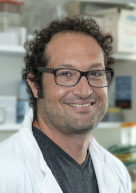
Dreams (Drug REpurposing and Artificial intelligence for Muscular disorderS) is an innovative project funded under a European call for tenders for 5 years, with the aim of developing an innovative methodology combining AI, stem cells and pharmacological screening to identify treatments for 5 muscular disorders. It is coordinated by Dr Xavier Nissan, Director of Research at the I-Stem laboratory, and brings together 8 other partners (1), including the Institut de Myologie.
Interview with Stéphane Vassilopoulos, co-leader of the Muscle Cell Organisation and Therapy of Centronuclear Dominant Myopathy team at the MCR (2), which is involved in this major project.
What is the aim of Dreams?
The aim of the project is to identify defects common to several diseases (3) that are sufficiently important to be chosen as targets for therapies. The first parameter to be targeted is autophagy, a natural process that occurs in all cells and enables its components to be recycled. It has been found that in many myopathies, the muscle cell is unable to carry out autophagy correctly; the mechanism is deregulated (too much or too little autophagy). The second parameter targeted is the aggregation of a type of cytoskeleton, intermediate filaments, in particular desmin.
The idea is to ‘repurpose’ drugs, i.e. reuse molecules that are already known and screen them on patient cells to improve phenotypes with autophagy or intermediate filament aggregation defects.
How is it original?
The innovation in this project is the idea of targeting defective pathways in several muscle diseases at the same time. The second innovation is the use of AI, or machine learning, to improve drug candidates. Finally, the consortium’s strength lies in its ability to conduct all phases of the study, from preclinical to clinical, on the molecules we discover.
What are the main stages?
The first stage will involve producing IPs cells (4) from patients, reprogramming them into muscle cells and identifying the molecular pathways that are disrupted.
Secondly, AI will be used to identify targets that can be tested using high-throughput screening with known molecules from the chemical libraries.
In the third stage, AI will enable in silico drug design, i.e. improving the efficacy of these targets.
In the fourth and final stage of the project, the drug candidates will be evaluated in patients, using an adaptive clinical trial system (5) based on the molecules that emerge.
What stages will the Institute’s teams be involved in?
We will be pooling our expertise and intervening at several stages.
The Myobank team (6) is making available skin fibroblasts from patients suffering from one of the 5 diseases being studied.
Antoine Muchir’s team (7), which works on laminopaties in which there are aggregates of intermediate filaments and abnormally low autophagy, and my team (which works on centronuclear myopathies) will also be involved.
Initially, we are going to use our expertise in physiopathology and cell biology to describe the IPs cells of the 5 pathologies, using microscopy and electron microscopy, analysis of protein expression, etc. Then, after the discovery of new molecules, we are going to study the cell biology of the IPs cells.
Then, once we have discovered the new molecules, we will demonstrate their effects, beneficial or otherwise, on IP cells.
Thirdly, we will inject them into mouse models and study their effects in vivo. At the Institute of Myology, we have developed genetic mouse and cell models to test the screened molecules that will be deemed promising. Teresinha Evangelista’s team (8) will also provide histological expertise throughout these various stages.
Finally, the I-Motion team (9) will carry out adaptive clinical trials on patients: study design, injections and patient follow-up to assess the effects of the selected molecules.
______________________
(1) The DREAMS consortium brings together 9 European partners – clinicians, patients, academic researchers and private partners: I-Stem (France), the French leader in pluripotent stem cell research created by AFM-Téléthon; Kantify (Belgium), a biotech company specialising in artificial intelligence; Institut de Myologie (France), an international reference centre dedicated to muscle science and medicine; Center for Neuroscience and Cell Biology – University of Coimbra (Portugal); Technion – Israel Institute of Technology (Israel); Samsara Therapeutics (UK); Assistance publique – Hôpitaux de Paris (France); AFM-Téléthon (France); Zabala Innovation (Spain).
(2) Stéphane Vassilopoulos, PhD, co-leader of the Muscle Organization & Therapy of Dominant Centronuclear Myopathy team, at the Myology Centre for Research of the Institute.
(3) The pathologies are Duchenne myopathy, centronuclear myopathy, Emery-Dreifuss myopathy, Pompe disease and Danon disease.
(4) Patients’ cells (often derived from skin, as muscle cells are difficult to obtain) are dedifferentiated into pluripotent IPs cells and redifferentiated into muscle cells. This is the expertise of the I-Stem laboratory.
(5) This type of clinical trial accelerates trials by reducing the number of different phases, and allows the adoption of seamless design.
(6) Myobank, research tissue bank of the Institute of Myology, headed by Pr Bertrand Fontaine.
(7) Antoine Muchir, PhD, leader of the Signaling Pathways & Striated Muscles team, at the Myology Centre for Research of the Institute.
(8) Dr Teresinha Evangelista, leader the Morphological unit at the Neuromuscular Investigation Center of the Institute.
(9) Dr Giorgia Querin, leader of the two clinical trial platforms for neuromuscular diseases, I-Motion Pediatric and I-Motion Adults at the Institute.
Read I-Stem press release (29/11/2023) DREAMS – a new Horizon Europe project brings hope to rare disease patients
